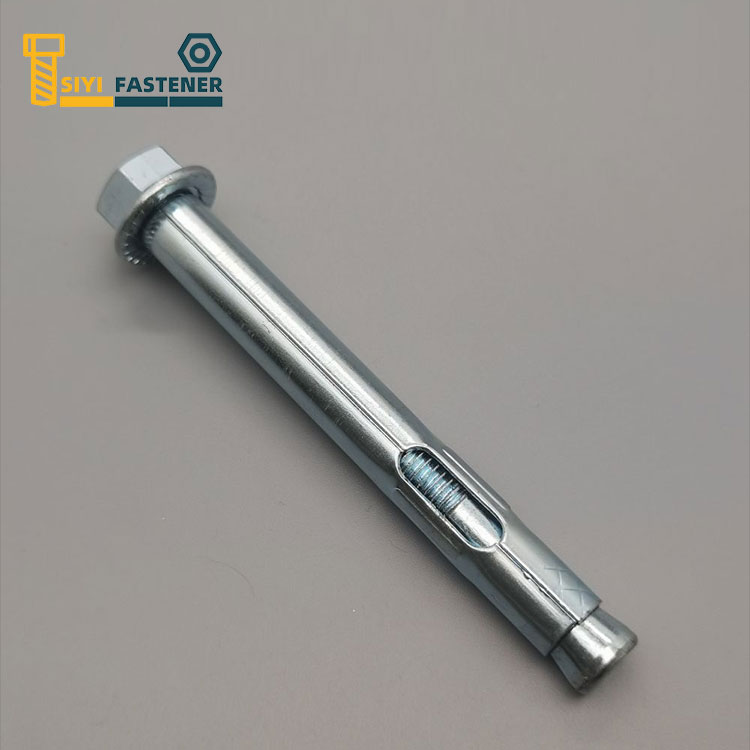How to Properly Install Carbon Steel Bluewhite Zinc Plated Sleeve Anchors with Flange Nut
2024-07-10
Introduction
Proper installation of sleeve anchors is crucial to ensure their effectiveness and reliability. The carbon steel bluewhite zinc plated sleeve anchor with flange nut is a popular choice for various fastening applications due to its strength and corrosion resistance. In this blog, we will provide a step-by-step guide to installing these sleeve anchors correctly, along with tips for ensuring a secure and long-lasting hold.
Tools and Materials Needed
- Drill: A power drill with a masonry bit suitable for the diameter of the sleeve anchor.
- Hammer: For driving the anchor into the hole.
- Wrench or Socket: To tighten the flange nut.
- Safety Gear: Safety glasses, gloves, and ear protection.
Step-by-Step Installation Guide
1. Prepare the Surface
- Clean the Surface: Ensure the surface where you will install the anchor is clean and free of dust, debris, and loose particles. This helps achieve a secure hold.
- Mark the Drill Point: Use a pencil or marker to mark the exact point where you will drill the hole. Ensure it aligns with the mounting holes of the item you are fastening.
2. Drill the Hole
- Select the Drill Bit: Choose a masonry bit that matches the diameter of the sleeve anchor. Refer to the manufacturer's instructions for the correct size.
- Drill to the Required Depth: Drill the hole to the depth specified by the anchor manufacturer. The hole should be slightly deeper than the length of the anchor to allow for proper expansion.
- Clean the Hole: After drilling, clean out any dust and debris from the hole using a brush or compressed air. This ensures the anchor will expand properly and hold securely.
3. Insert the Sleeve Anchor
- Position the Anchor: Insert the sleeve anchor into the hole, ensuring it is positioned straight and flush with the surface.
- Tap with a Hammer: Gently tap the anchor with a hammer until it is fully seated in the hole.
4. Tighten the Flange Nut
- Align the Item to Be Fastened: Position the item you are fastening over the sleeve anchor and align the mounting holes.
- Install the Flange Nut: Place the flange nut on the threaded end of the anchor and hand-tighten it to hold the item in place.
- Tighten with a Wrench or Socket: Use a wrench or socket to tighten the flange nut securely. As you tighten, the anchor will expand, gripping the sides of the hole and securing the item in place.
Tips for Ensuring a Secure Installation
1. Use the Correct Drill Bit Size
- Accuracy Matters: Using the correct drill bit size ensures the anchor fits snugly in the hole and expands properly for a secure hold.
2. Drill Straight and to the Correct Depth
- Avoid Angled Holes: Drilling at an angle can compromise the anchor's hold. Ensure the hole is drilled straight and to the specified depth for optimal performance.
3. Clean the Hole Thoroughly
- Remove Debris: Dust and debris can prevent the anchor from expanding properly. Clean the hole thoroughly to ensure a secure fit.
4. Tighten the Flange Nut Properly
- Avoid Over-Tightening: Over-tightening can strip the threads or damage the anchor. Tighten the flange nut until it is snug and the anchor is fully expanded.
5. Follow Manufacturer's Instructions
- Adhere to Guidelines: Always follow the manufacturer's instructions for installation, including recommended hole size, depth, and torque specifications.
Conclusion
Installing carbon steel bluewhite zinc plated sleeve anchors with flange nuts is a straightforward process that requires attention to detail and adherence to proper techniques. By following the step-by-step guide and tips provided in this blog, you can ensure a secure and reliable installation for your fastening needs. Whether you are working on a professional construction project or a DIY task, these sleeve anchors offer the strength and durability needed for a wide range of applications.



